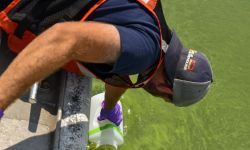Michigan gets $290M boost for water upgrades as Flint crisis anniversary nears


- Michigan’s aging water infrastructure is about to get a $290 million funding boost, as the state prepares to spend down bond money on the cause
- The money comes from a 2002 voter-authorized bond
- It’s still far short of the estimated need as Michigan contends with billions in deferred maintenance to water systems
Michigan will soon deploy $290 million in bonding authority to boost lead pipe replacements and update drinking water and sewer systems across the state, Gov. Gretchen Whitmer announced Monday.
The money comes from the 2002 voter-approved Great Lakes Water Quality Bond, which the state is preparing to spend down as part of a $500 million water strategy that Whitmer first unveiled in 2020.
Announcing the funding on Earth Day and just three days before the 10th anniversary of the Flint water crisis, Whitmer said “safe drinking water must be a guarantee.”
Related:
- Gov. Whitmer unveils $500M spending strategy for Michigan water
- Some MI water systems are overbuilt, underfunded. Are mergers the answer?
- High costs, few customers: Benton Harbor water woes loom for Michigan cities
- Michigan is spending big on infrastructure. Its problems are even bigger.
“Every parent should have the confidence to give their child a glass of drinking water from the sink when they sit down at the table,” Whitmer said, while acknowledging that Michigan has too often “fallen short on that promise.”
In the decade since Flint’s notorious water crisis, lawmakers have ramped up spending on water infrastructure primarily by funneling billions of federal COVID stimulus and infrastructure dollars to the cause.
The biggest infusion came in 2022, when lawmakers passed a bipartisan spending bill that included nearly $2 billion for water systems.
Yet as Bridge Michigan has reported, Michigan needs even more.
Communities across the state are contending with aging infrastructure, frequent breakdowns and steep rate hikes after decades of deferred maintenance.
The root causes: Past political pressure to keep water rates low, which shifted maintenance costs onto today’s users; a long-term decline in federal funding for water infrastructure, and suburban sprawl that has added more pipes, plants and pumps, even while Michigan struggled to maintain its existing inventory.
Phil Roos, director of the Michigan Department of Environment, Great Lakes and Energy, said the bond money will enable EGLE to dole out more grants and loans to repair water treatment plants, upgrade sewers, remove lead lines and more.
But he acknowledged “we have a lot more to do.”
Then-Gov. Rick Snyder’s 21st Century Infrastructure Commission recommended in 2016 that the state spend nearly $1 billion annually on water infrastructure upgrades over the next two decades. The price tag has only grown in the years since.
This year, Roos said, local governments have asked his agency for a combined total of $3.5 billion in water funding. Even with the $290 million boost announced Monday, EGLE only expects to be able to fulfill about 28 percent of those requests.
Beyond seeking more money to maintain its water systems, experts say Michigan communities should consider consolidating water systems to regain cost-efficiencies that were lost by sprawl.
For instance, Benton Harbor’s water system now operates at just a tenth of its capacity, in part because two neighboring townships left the system and built their own plants just down the road.
The combined capacity of three water plants within a few miles of each other could serve the region multiple times over.
Michigan Environment Watch
Michigan Environment Watch examines how public policy, industry, and other factors interact with the state’s trove of natural resources.
- See full coverage
- Subscribe
- Share tips and questions with Bridge environment reporter Kelly House
Michigan Environment Watch is made possible by generous financial support from:
Our generous Environment Watch underwriters encourage Bridge Michigan readers to also support civic journalism by becoming Bridge members. Please consider joining today.
See what new members are saying about why they donated to Bridge Michigan:
- “In order for this information to be accurate and unbiased it must be underwritten by its readers, not by special interests.” - Larry S.
- “Not many other media sources report on the topics Bridge does.” - Susan B.
- “Your journalism is outstanding and rare these days.” - Mark S.
If you want to ensure the future of nonpartisan, nonprofit Michigan journalism, please become a member today. You, too, will be asked why you donated and maybe we'll feature your quote next time!




